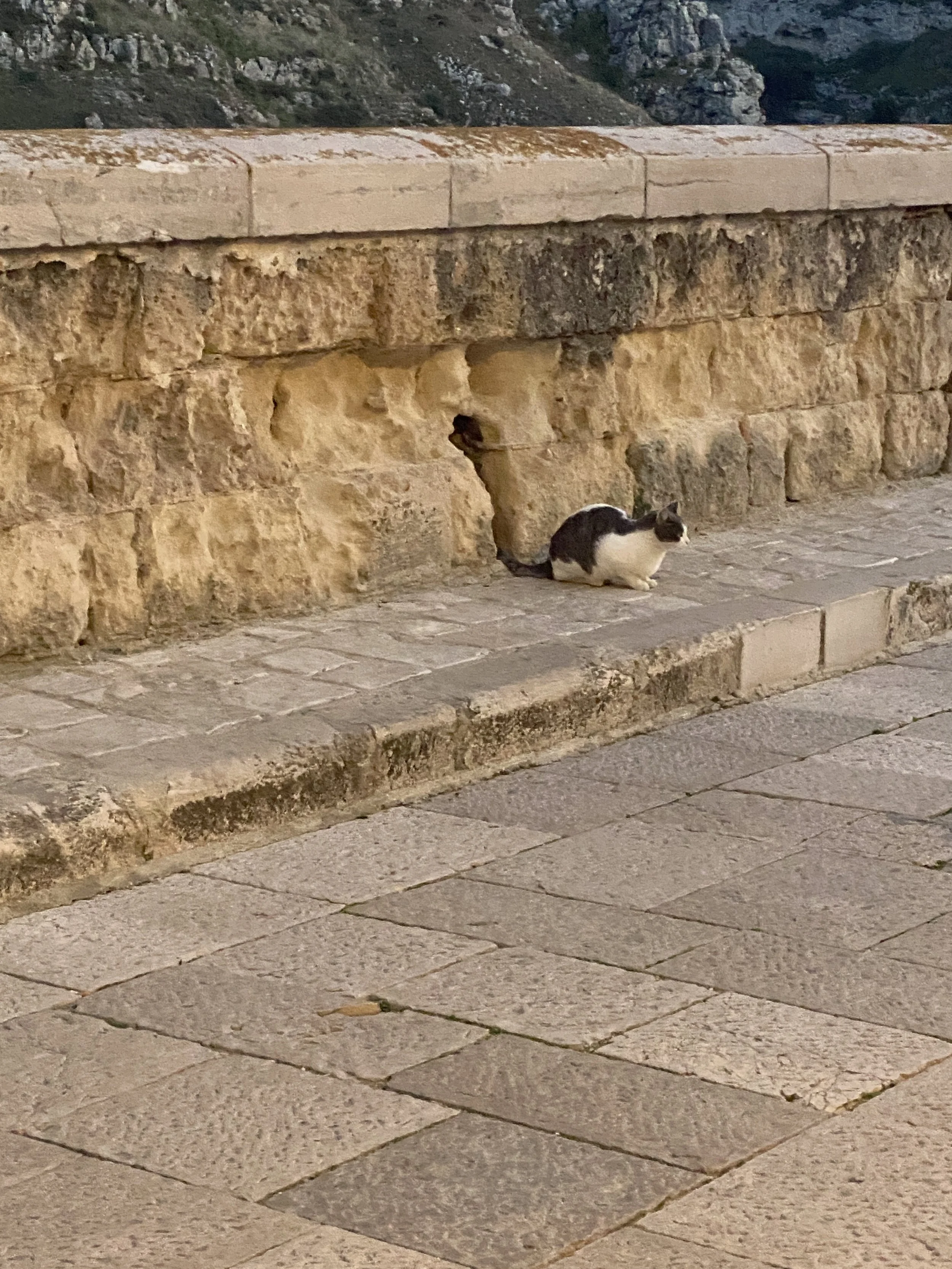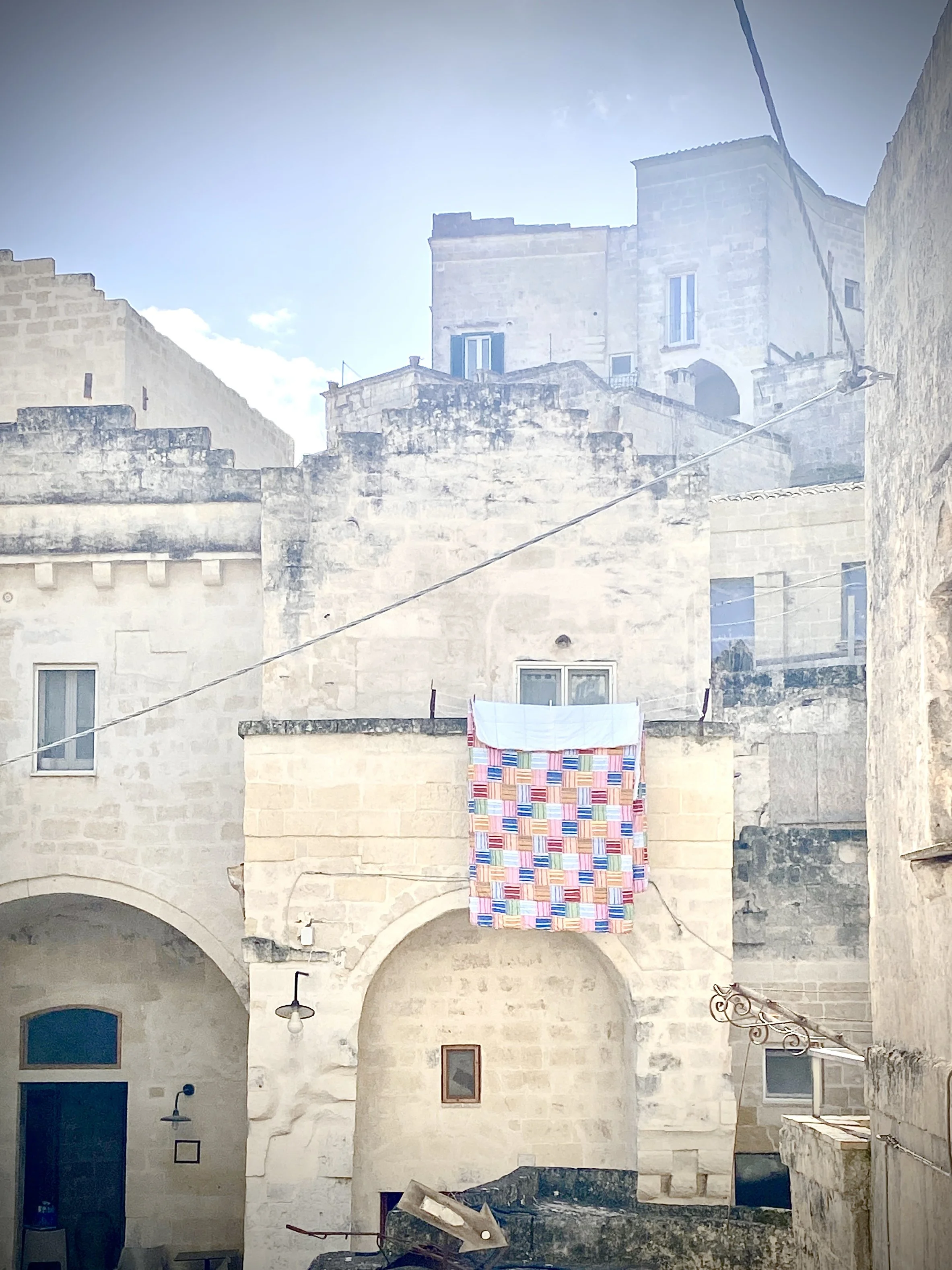Matera Revisited: A Literary Journey into the Sassi
/It’s been five years since I wrote my trip report about Matera, and the city has not lost its ability to astound. There are more restaurants and cafés tucked into the Sassi now, and tourism has climbed, but wandering those ancient streets—especially at daybreak or dusk—still feels like stepping into a world where history exhales through the stones. If you visit Matera (and I hope you do), I recommend staying in the Sassi, though perhaps not for long. If you skew sensitive as I do, the atmosphere can feel intense. Two days was plenty for me—though I could happily spend far longer in the lively modern city above (more on that juxtaposition in my first post).
Either way, carve out time to walk the Sassi alone. Even if you’re traveling with others, slip into the quiet streets before the tourists arrive or after they’ve drifted off to dinner. Walk without destination. Let your thoughts be your guide. Leave room for shadows to visit. It’s not always comfortable to open yourself that way, but that’s when Matera finally speaks.
Walking alone, I felt like a vessel—holding stories I didn’t fully understand. Tears rose in my eyes for no definable reason. I wandered deeper into the Sassi to commune with ghosts, call to the cats slim as slivers of light, and breathe in the dust of long-ago lives.
What makes the Sassi extraordinary—beyond their undeniable beauty—is that they form one of the oldest continuously inhabited landscapes on earth. For thousands of years, people carved their homes directly into the soft tufa cliffs, expanding caves into dwellings, chapels, cisterns, and entire neighborhoods. Life here was ingenious and communal: rainwater collected through a complex system of channels, families lived above their animals for warmth, and the entire hillside functioned like a living organism. By the 20th century, though, poverty, disease, and overcrowding turned these once-thriving cave communities into a national symbol of neglect. When Italy relocated residents in the 1950s, the Sassi were abandoned—left as a kind of open wound in the country’s conscience.
discovering the community ovens in Matera’s sassi
And yet revival came. Restoration efforts began in the 1980s; UNESCO designation followed in 1993, recognizing the Sassi as a rare example of human adaptation to harsh terrain. Slowly, Matera transformed from “the shame of Italy” into one of its most arresting destinations. Today travelers come for the cinematic drama of the landscape, the labyrinth of alleys that seem to fold time, the rock-hewn churches painted with centuries-old frescoes, and the thrill of sleeping in rooms that once sheltered Bronze Age families. Tourism has grown, yes—but the draw isn’t trendiness. It’s the sense that Matera allows you to stand inside the long arc of human endurance, close enough to feel it hum beneath your feet.
Powerful stuff.
That staggering nature of the Sassi stayed constant across visits; otherwise, this recent stopover felt quite different, as this time, I traveled with Max, a co-owner of Ciao Andiamo, and our Book Club with a View. Which meant:
We stayed in a wildly cool hotel in the Sassi (my bathroom had a small pool—on FaceTime, Gabe squinted and asked, “Your room comes with a portal??”)
We finally took the tour I missed the first time around—one that made the Sassi come alive and answered questions I didn’t know I had, like why people settled here in the first place or how the area remained so well preserved (so fascinating that the Romans found it too vulnerable to bother conquering, and thus never remodeled it to their specifications)
That tour included visits to the ancient cistern which elucidated the community rhythms around water, as well as helping me picture how neighborhoods grew up around courtyards. With houses being small and dark, most of people’s lives were lived out doors in those courtyards, filled with daily connection. This really brought home how devastating it would have been for these families to be forced into apartment complexes on the outskirts of Matera. Where were the women to gather with to shell beans, where were the men to swap stories over the cistern about where to get work? The whole structure of their community came crashing down.
The tour also led us into the church of Santa Lucia alle Malve, a rock church that, after its religious community dispersed, was converted into a private home and lived in well into the 20th century. Its blend of faded frescoes and everyday household niches shows how sacred sites in the Sassi were repeatedly adapted to meet the needs of later residents. I loved it partly partly because it matches the title of my first novel, partly because our tour guide secured by Ciao Andiamo told some excellent stories, but also and also because walking through it, you can feel the strata of Matera’s history—frescoed saints sharing space with traces of domestic life carved directly into the stone.
The whole experience, as part of the Book Club with a View, came layered with literature.
On our reading list was Seasons in Basilicata by David Yeadon, in which the author moves to Aliano—where Carlo Levi, author of Christ Stopped at Eboli, was exiled by Mussolini in the 1930s. I went into the trip knowing almost nothing about Levi, other than that I kept trying—and failing—to push past page three of his book. Yeadon includes Levi’s writing in his own, and it turned out to be exactly the dose I needed: enough to understand Levi’s radical empathy, but not enough to overwhelm me.
For those equally unfamiliar: Carlo Levi was born in Turin and was Jewish, both of which helped position him as an outsider to southern Italy. That vantage point allowed him to see the people of the Mezzogiorno not as inherently backward, as previous intellectuals had proclaimed, but as individuals surviving harsh conditions imposed by indifferent government, calcified traditions, and a church that had turned its back on them. Levi recognized that their suffering was systemic, not personal. Naturally, governments don’t relish being indicted for neglect, so Mussolini’s regime exiled him. That, in turn, is why many locals still revere him today.
Yeadon, too, is an outsider—British-American—and because we had read Elena Ferrante’s My Brilliant Friend earlier in the trip, we found ourselves deep in a lively cocktail-hour conversation: How does a writer’s “outsider” status shape the way they tell stories? And is there an ethical responsibility in how foreigners portray rural Italy?
One reason I wanted the group to read Seasons in Basilicata is Yeadon’s vivid depiction of the region’s folklore. On my first visit, I hadn’t thought much about it, but a place like Basilicata—remote, “forgotten” according to Levi—is fertile ground for older, pagan beliefs to linger. Over glasses of wine, we talked about how people fill the void left when institutions like government, church, or healthcare fail them. No wonder Yeadon encounters tales of werewolves and hags offered as everyday explanations for the strange.
Other questions we explored as a group:
Yeadon doesn’t chase Instagram moments—he stays, observes, listens. How can we find authentic travel experiences in an increasingly digital world?
Yeadon writes, “Nothing in Basilicata hurries, and yet everything happens.” Maybe that’s the book’s beating heart—an invitation to let time stretch, to let a place shift you before you try to shape it. What’s one “slow” travel moment from your own life that still lingers?
Yeadon includes a regional mantra: Chi si accontenta, gode. He who accepts, enjoys. Could we, at the start of our week together, adopt that as our group motto? (Spoiler: we did.)
Want travel-writing like this in your inbox once a month? Sign up for the Grapevine, and you’ll get wanderlust stories, book recommendations, and giveaways. Plus, as a special welcome to the Grapevine community, I’ll send you my best-selling novel, Santa Lucia. Just think! In mere moments you can sink into the smells, sights, and mysteries of bella Italia.






















